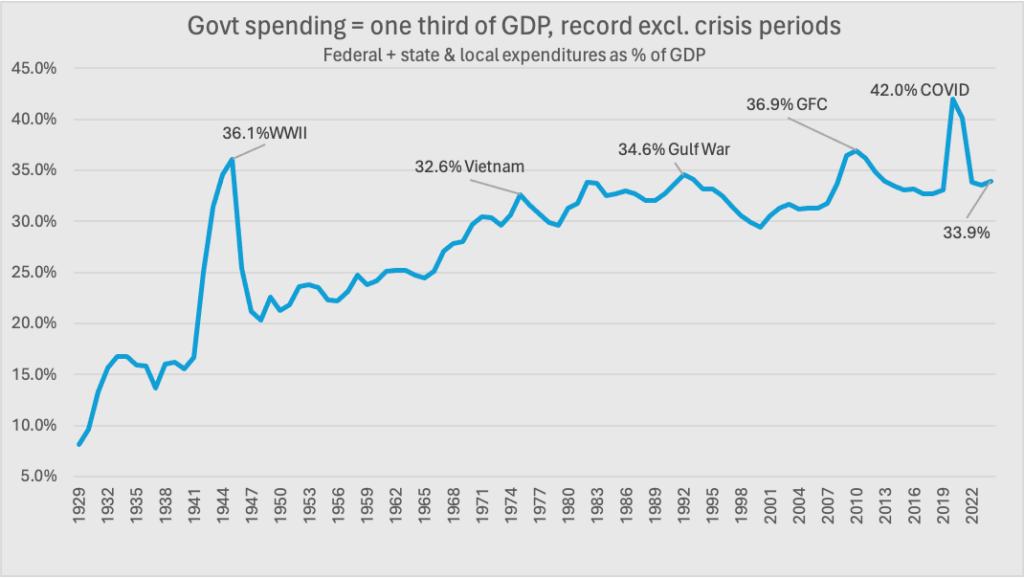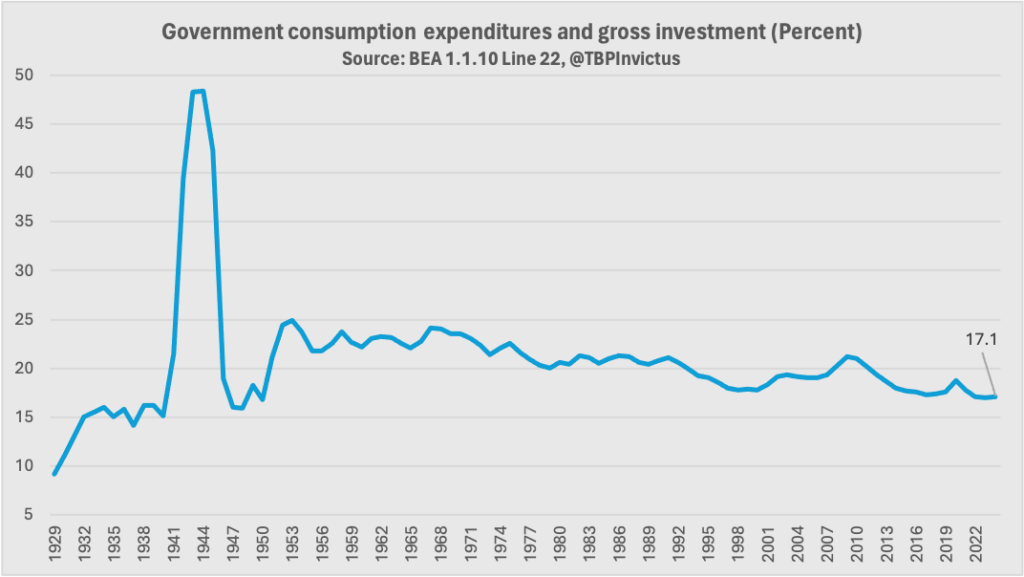

Calculation: BEA Desk 3.1 Line 20 (Present Expenditures) divided by Desk 1.1.5 Line 1 (GDP). Alternatively, Merchandise #2 under divided by GDP.
“When you torture information lengthy sufficient, it should confess to something.” –Ronald Coase
Hey, it’s @TBPInvictus. Let’s delve right into a living proof of Coase’s theorem:
When you needed to hawk the narrative that authorities spending is uncontrolled, you would possibly current a chart just like the one above, which is an actual reproduction of a chart that appeared lately in a chunk of analysis from a significant Wall St. funding agency. I’ve painstakingly replicated it as a substitute of doing a replica and paste in order to keep away from straight figuring out the offending agency (for causes that may change into obvious).
After that chart, you’d be forgiven for believing that authorities spending was uncontrolled. 34% of GDP throughout a interval of relative stability! As excessive now as throughout the Gulf Warfare, greater than throughout Vietnam, and rattling close to as excessive as World Warfare II. How can this be? Perhaps my animus towards DOGE is misplaced.
The textual content accompanying that chart reads: “Consumption: in 2024, one third of GDP got here from authorities spending, a report excessive excluding intervals of conflict or disaster; this was financed by 6-7% funds deficits, one other unwelcome peacetime report.”
It goes with out saying that politics should not have any place in any respected agency’s Analysis division (see Why Politics and Investing don’t combine). That has been the case over a long time of studying the whole lot. And it’s attainable that that is an sincere error as a result of, in spite of everything, there’s a ton of knowledge on the market and it’s very simple to make an occasional mistake. Been there, carried out that.
~~~
Now, then again, what would possibly you consider authorities spending when you noticed the chart under:


Alternatively, Merchandise #1 under divided by GDP, correctly correctly be carried out to deal with consumption and funding.
You’ll most likely assume authorities spending just isn’t, in actual fact, uncontrolled and DOGE may be an enormous waste of time (or serving another goal).
As Paul Krugman lately wrote on his glorious Substack, utilizing a chart an identical to the one instantly above (Paul used FRED):
“Folks could think about that authorities is an even bigger a part of the financial system than it’s due to all the cash we spend supporting retired People, masking their well being payments, and so forth [Chart 1]. However that sort of spending isn’t counted as a part of GDP — the entire worth of products and companies produced in America — as a result of Social Safety and different advantages are merely transfers of earnings between People. Solely spending by Social Safety recipients counts towards GDP. The one authorities spending that straight impacts GDP — the spending Bessent says must fall — is spending that straight buys items and companies.” [Chart 2].
What’s the distinction between the 2 charts? Which one is telling us the reality?
The primary chart is inaccurate and terribly deceptive, and right here’s why: The denominator of each charts is GDP. The distinction lies with the numerator. The scary (prime) chart has as its numerator Present Expenditures, BEA Desk 3.1, Line 20, at present $9.9071 trillion. Divided by present GDP of $29.1838 million offers us a quotient of 33.9%. Right here’s the issue with that: That $9.9071 trillion numerator is approach, approach over-inflated for the acknowledged declare, i.e. “consumption.” By about 2x over-inflated. BEA has a wonderful FAQ on authorities spending that resides right here. It breaks down authorities spending as follows (emphasis mine):
- Authorities consumption expenditures and gross funding: This can be a measure of presidency spending on items and companies which are included in GDP. Consumption expenditures embrace what authorities spends on its work drive and for items and companies, akin to gasoline for army jets and hire for presidency buildings and different buildings. Gross funding consists of what authorities spends on buildings, tools, and software program, akin to new highways, colleges, and computer systems.
- Authorities present expenditures: Complete spending by authorities is way bigger than the spending included in GDP. Present expenditures measures all spending by authorities on current-period actions, and consists not solely of presidency consumption expenditures, but in addition present switch funds, curiosity funds, and subsidies (and removes wage accruals much less disbursements). Funds akin to switch funds and curiosity funds are excluded from the calculation of GDP as a result of these funds don’t signify purchases of products and companies, although earnings from switch and curiosity funds could fund consumption expenditures or funding in different sectors of the financial system.
- Complete authorities expenditures: Along with the transactions which are included in present expenditures, this measure consists of gross funding (as outlined earlier), and different capital-type expenditures that have an effect on future-period actions, akin to capital switch funds and web purchases of nonproduced property (for instance, land). Complete expenditures exclude consumption of mounted capital (CFC), which is a noncash cost.
The $9.9071 trillion numerator consists of “present switch funds, curiosity funds, and subsidies (and removes wage accruals much less disbursements),” none of which belong when analyzing “Consumption.”
“Switch Funds,” for the uninitiated, embrace things like Social Safety advantages. The extra applicable quantity — Gov’t Consumption Expenditures and Gross Funding — is $4.9893T ($4.9893/$29.1838 = 17.1%). Each the Wall St. store concerned and Scott Bessent absolutely know this, however the second chart is ineffective in advancing a government-spending-is-out-of-control-and-DOGE-will-put-an-end-to-it narrative.
Barry likes to remind us of the nice Joan Robinson quote, and its totally applicable right here:
“The aim of finding out economics is to not purchase a set of ready-made solutions to financial questions, however to discover ways to keep away from being deceived by economists.”
Issues are sometimes not what they appear, and infrequently not as you’re instructed. Concentrate.




